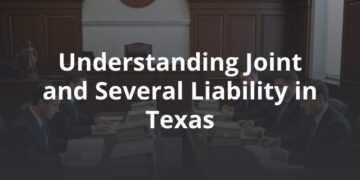Hospitals in Texas are required to provide treatment to people in need, such as car accident victims. Texas protects those hospitals, and other emergency medical providers, by allowing them to file a hospital lien for their reasonable medical bills, which puts the public on notice they are owed money. Insurance companies will not pay your settlement until they are satisfied the hospital lien has been resolved, which can result in huge delays before you receive your money. So, if you got notice in the mail and are asking yourself “what is a hospital lien?”, now you know it is the hospital’s way of guaranteeing they get paid for the bill.
According to Chapter 55 of the Texas Property Code, if you are injured in an accident “that is attributed to the negligence of another person,” and you receive emergency medical services at a hospital, the hospital can file a lien in the county where the services were provided, putting the public on notice that they are owed money. The lien gives the hospital and emergency service providers the right to be paid first out of any settlement from a negligent third-party.
It is common for hospitals to refuse to submit their bills to the patient’s health insurance when they know the treatment is provided as part of a car accident. It is also common for health insurance companies to refuse to pay for emergency medical treatment when the injury was caused by a negligent third-party and there is auto insurance available. In those situations, the hospital will commonly rely on their lien to claim they are owed a much higher amount for their services than they would be owed if health insurance were involved. Because the negligent third-party’s insurance company will refuse to pay your settlement proceeds when there is a hospital lien on file, you might find yourself being bullied into paying much higher rates for your medical care than your should. This can significantly reduce the amount of money you receive out of the settlement. Understanding how to combat this tactic begins with understanding Texas law governing hospital and emergency medical services liens.
Sec. 55. 002 defines when a hospital has a lien on a claim or cause of action. You must receive treatment in the first 72 hours (3 days) following an injury for a hospital to be able to attach a lien. If you receive treatment more than 72 hours after your injury, the hospital lien can’t attach and is invalid. If your treatment requires treatment at an additional hospital, the law allows a lien to extend to that additional hospital. If the county you receive treatment in has a population higher than 800,000, then the emergency medical service provider (EMS) doesn’t have a lien. According to data extracted from the U.S. Census Bureau, the only counties in Texas where this currently applies are: Denton, El Paso, Hidalgo, Collin, Travis, Bexar, Tarrant, Dallas, and Harris.
Sec. 55.003 defines property to which a hospital or emergency medical services lien attaches. A lien attaches to a cause of action for damages, a Texas court judgement, the decision of a public agency, or the proceeds of a settlement of a cause of action. In other words, the lien will attach to your personal injury claim whether it settles or goes to trial. However, if you receive settlement proceeds before the hospital lien is filed, the hospital lien has no effect. Additionally, a lien can’t attach to a worker’s compensation claim, the Federal Employees Liability Act, the Federal Longshore and Harbor Worker’s Compensation Act, and rare cases involving an owner or operator of a railroad company. If you have uninsured or underinsured motorist coverage or personal injury protection under your auto insurance, the lien will not attach to proceeds from those policies. The exception is public liability insurance; a lien can attach to claims under a public liability insurance policy.
Sec. 55.004 deals with the amount allowed in a lien. This section says the lien can only apply to “the first 100 days of the injured individual’s hospitalization.” Any treatment following the first 100 days can’t be included in a lien. The lien “may also include the amount of a physician’s reasonable and necessary charges for emergency hospital care services provided to the injured individual during the first seven days of the injured individual’s hospitalization.” This piece of the statue is geared toward ER physicians, who often issue a bill separate from the hospital. The physician can request for the hospital to act on the physician’s behalf in securing and collecting the lien.
The lien amount can’t cover charges for “services that exceed a reasonable and regular rate for the services.” If you can prove that the charges in a lien exceed a reasonable or regular rate, then the amount of the lien can be reduced. If the hospital or medical services provider can recover payment from a health insurance plan or program, those charges should not be included in the amount of a lien. If you received services from an ambulance in the first 72 hours after your injury, the lien amount cannot be over $1,000.
Hospitals and medical service providers are required to take the following steps to secure a lien:
- Send a notice to the injured individual that includes their name, address, date of the accident, name and location of the hospital or provider claiming the lien, and the name of the liable person if known.
- File the lien with the county clerk of the county were the services were provided before money is paid to the injured party because of the injury.
- After a hospital or provider receives notice from the county clerk that the lien is filed, the hospital or provider has five business days to send a written notice to the injured individual or the legal representative of the injured individual by regular mail to the last known address.
If a provider follows these rules, then the lien is generally valid. If the provider fails to follow these guidelines, then the validity of the lien can be questioned.
Lien-holding hospitals and providers will sometimes negotiate the amount of a lien, but understanding the proper leverage points depends on the circumstances of each case. Hiring a personal injury lawyer that understands the ins-and-outs of hospital liens can help in the negotiation process.
What can I do about the hospital lien?
There are a number of ways to handle your hospital lien effectively, so you can get your settlement across the finish line:
- Force the hospital to use your health insurance. Because hospital liens are so powerful, hospitals will often rely on their lien rather than using your health insurance. This is because they will probably get paid less if they use their health insurance than if they hijack your personal injury settlement and hold it hostage. But if you have health insurance and demand the hospital submit your bill, you can reduce the hospital’s bill, and also reduce how much their lien is for.
- Negotiate with the hospital. Hospital bill charges are not always set in stone. If you don’t have health insurance or it is too late to use it, you can call the hospital and negotiate. There are tools available to the public, such as fairhealth.org, to help you understand what the reasonable bill should be for your charges. Sometimes, the hospital will reduce their charges in exchange for prompt payment.
- Sue the hospital and challenge the lien. This is never ideal, but a hospital lien is only valid if the charges it protects are reasonable. There is much debate about reasonableness of hospital bills, and ways to prove the hospital has overcharged you. Suing the hospital and proving their bills are unreasonable can invalidate the hospital lien.
- Pay the bill. If you are satisfied with the settlement and the hospital bill is not egregious, then you can either pay the bill or instruct the insurance company to pay the bill out of the settlement.
The personal injury lawyers at FVF have handled hundreds of hospital liens and are very familiar with how to handle them. If you have questions about a hospital lien or your personal injury case, please do not hesitate to contact us for a no-cost, no-pressure case evaluation.
References






